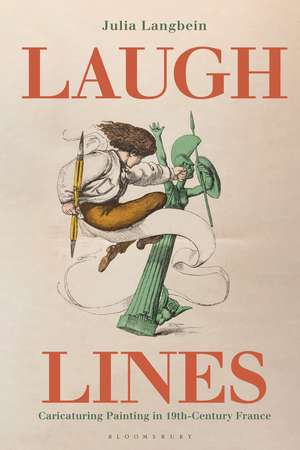Laugh Lines: Caricaturing Painting in Nineteenth-Century France
Autor Julia Langbeinen Limba Engleză Hardback – 9 mar 2022
Preț: 544.27 lei
Preț vechi: 776.29 lei
-30% Nou
Puncte Express: 816
Preț estimativ în valută:
104.17€ • 108.33$ • 87.17£
104.17€ • 108.33$ • 87.17£
Carte disponibilă
Livrare economică 22 februarie-08 martie
Preluare comenzi: 021 569.72.76
Specificații
ISBN-13: 9781350186859
ISBN-10: 1350186856
Pagini: 256
Ilustrații: 43 colour and 46 bw illus
Dimensiuni: 156 x 234 x 23 mm
Greutate: 0.76 kg
Editura: Bloomsbury Publishing
Colecția Bloomsbury Visual Arts
Locul publicării:London, United Kingdom
ISBN-10: 1350186856
Pagini: 256
Ilustrații: 43 colour and 46 bw illus
Dimensiuni: 156 x 234 x 23 mm
Greutate: 0.76 kg
Editura: Bloomsbury Publishing
Colecția Bloomsbury Visual Arts
Locul publicării:London, United Kingdom
Caracteristici
Interrogates Salon caricature not only as a representation of painting, but of painting and spectatorship within a particular exhibition context
Notă biografică
Julia Langbein is Research Fellow at Trinity College Dublin, Ireland. An art historian specialising in nineteenth-century popular visual culture, she previously held a postdoctoral research fellowship at the University of Oxford, UK.
Cuprins
List of PlatesList of FiguresIntroduction1. Comic Reproduction in July Monarchy Paris2. Dueling and Doubling: The Antagonism of Salon Caricature3. Salon Caricature and The Physiognomy of Paint 4. Salon Caricature in the age of Reproduction. 5. Gravity and Graphic Medium in Cham and Daumier6. Caricature and Comic Spectacle at the Paris Salon 7. Salon Caricature and the Making of ManetConclusionBibliographyIndex
Recenzii
Widely researched, and lavishly illustrated, Laugh Lines, makes both a challenging and inspirational reading. Supported by ample studies of the abundant primary sources, from Baudelaire and Champfleury to Grand-Carteret and Duret, as well as archival material in the Bibliothèque Nationale, the book straddles several areas: reproductive technologies, the practices of physiognomy, photography, Salon history, as well as into cultures of art viewing and the perception of laughter in nineteenth-century France.The book's unquestionable strength are visual analyses. Langbein takes the readers on captivating journeys, which move with confidence between the original works by Delacroix, Ribot and many lesser-known artists, and the 'hyperactive lines' of the rapidly drawn caricatures by Cham and Bertall, sometimes including also polite reproductive engravings of the same paintings for comparison.
Laugh Lines makes a significant contribution to our understanding of cultural and artistic changes in France from the 1840s to 1880s. It offers an important corrective to the historiography on caricature and modernist painting, and illuminates shifting relations between visual art, literature, and journalism.
In this enthralling study of nineteenth-century Salon caricature, distinctive but neglected artists like Bertall and Cham benefit from being compared with Daumier and Nadar in a wide-ranging historical analysis which explores the extensive variety of printmaking techniques available at the time.
Julia Langbein's engaging and impeccably researched volume enriches our comprehension of the spatial and social dynamics of Salon spectatorship. It will become required reading for anyone interested in art headquartered in nineteenth-century Paris.
Laugh Lines makes a significant contribution to our understanding of cultural and artistic changes in France from the 1840s to 1880s. It offers an important corrective to the historiography on caricature and modernist painting, and illuminates shifting relations between visual art, literature, and journalism.
In this enthralling study of nineteenth-century Salon caricature, distinctive but neglected artists like Bertall and Cham benefit from being compared with Daumier and Nadar in a wide-ranging historical analysis which explores the extensive variety of printmaking techniques available at the time.
Julia Langbein's engaging and impeccably researched volume enriches our comprehension of the spatial and social dynamics of Salon spectatorship. It will become required reading for anyone interested in art headquartered in nineteenth-century Paris.
